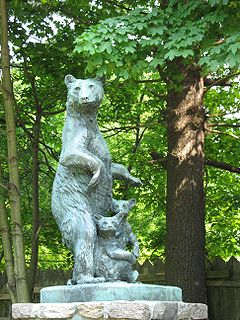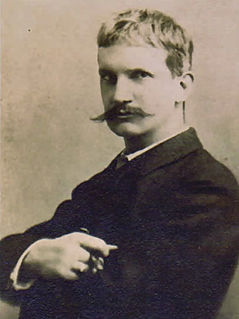
Israel Putnam, popularly known as "Old Put", was an American army general officer who fought with distinction at the Battle of Bunker Hill during the American Revolutionary War (1775–1783). He also served notably as an officer with Rogers' Rangers during the French and Indian War (1754–1763), when he was captured by Mohawk warriors. He was saved from the ritual burning given to enemies by the intervention of a French officer with whom the Mohawk were allied.

The history of sculpture in the United States begins in the 1600s "with the modest efforts of craftsmen who adorned gravestones, Bible boxes, and various utilitarian objects with simple low-relief decorations." American sculpture in its many forms, genres and guises has continuously contributed to the cultural landscape of world art into the 21st century.
Events from the year 1969 in art.

The Ulysses S. Grant Memorial is a presidential memorial in Washington, D.C., honoring American Civil War general and 18th United States President Ulysses S. Grant. It sits at the base of Capitol Hill, below the west front of the United States Capitol. Its central sculpture of Grant on horseback faces west, overlooking the Capitol Reflecting Pool and facing toward the Lincoln Memorial, which honors Grant's wartime president, Abraham Lincoln. Grant's statue is raised on a pedestal decorated with bronze reliefs of the infantry; flanking pedestals hold statues of protective lions and bronze representations of the Union cavalry and artillery. The whole is connected with marble covered platforms, balustrades, and stairs. The Grant and Lincoln memorials define the eastern and western ends, respectively, of the National Mall.

Anna Vaughn Hyatt Huntington was an American sculptor who was among New York City's most prominent sculptors in the early 20th century. At a time when very few women were successful artists, she had a thriving career. Hyatt Huntington exhibited often, traveled widely, received critical acclaim at home and abroad, and won multiple awards and commissions.

Collis P. Huntington State Park is a public recreation area covering 1,017 acres (412 ha) in the towns of Redding, Newtown, and Bethel in Fairfield County, Connecticut. The state park is noted for Anna Hyatt Huntington's sculptures of bears and wolves that welcome visitors at the park entrance. Her work can also be seen in the heroic sculpture of General Israel Putnam at Putnam Memorial State Park in Redding. The park bears the name of railroad magnate Collis Potter Huntington, whose heirs donated the lands to the state. The park's web of multi-use trails is open to hikers, cyclists, and equestrians. The park is managed by the Connecticut Department of Energy and Environmental Protection.

Putnam Memorial State Park is a history-oriented public recreation area in the town of Redding, Connecticut. The state park preserves the site that Major General Israel Putnam chose as the winter encampment for his men in the winter of 1778/1779 during the American Revolutionary War. It is Connecticut's oldest state park, created in 1887 at the instigation of Redding town residents. The park was listed on the National Register of Historic Places in 1970.

Atalaya and Brookgreen Gardens is a National Historic Landmark District encompassing two formerly-united properties associated with sculptor Anna Hyatt Huntington (1876-1973) on the coast of Georgetown County, South Carolina. The district includes Atalaya Castle, now part of Huntington Beach State Park, and the sculpture garden of Brookgreen Gardens, both properties part of a large estate developed by Anna and Archer M. Huntington in the 1930s. It includes the nation's first formal sculpture garden, and one of the studios at which Huntington did her most productive work. The district was designated a National Historic Landmark in 1992.
Roman Bronze Works, now operated as Roman Bronze Studios, is a bronze foundry in New York City. Established in 1897 by Riccardo Bertelli, it was the first American foundry to specialize in the lost-wax casting method, and was the country's pre-eminent art foundry during the American Renaissance.

Brenda Putnam was an American sculptor, teacher and author.

Karl Gerhardt was a United States sculptor, best known for his death mask of President Ulysses S. Grant and a portrait bust of Mark Twain.

Theodore Roosevelt, Rough Rider is a toppled bronze sculpture, now officially de-accessioned, by American artist Alexander Phimister Proctor, located in the South Park Blocks of Portland, Oregon in the United States. The equestrian statue was completed in 1922 and depicts Theodore Roosevelt as the leader of the cavalry regiment that fought during the Spanish–American War called the Rough Riders.
Harriet Randolph Hyatt Mayor (1868-1960) was an American artist and sculptor active in the late 19th century. She contributed work to the World's Columbian Exposition, among other exhibitions.

El Cid Campeador is an outdoor equestrian statue depicting the Spanish knight El Cid by artist Anna Hyatt Huntington, architect William Templeton Johnson, and the foundry General Bronze Company, installed at Balboa Park's Plaza de Panama, in San Diego, California. The bronze sculpture was created in 1927 and dedicated on July 5, 1930. The statue measures approximately 11 x 9 x 7 ft, with a 16-foot diameter, and its concrete or Indiana limestone base measures approximately 11 x 14 x 8 ft. It was surveyed and deemed "treatment needed" by the Smithsonian Institution's "Save Outdoor Sculpture!" program in March 1994.

Major General George Gordon Meade is an equestrian statue that stands in Philadelphia's Fairmount Park. The statue, which was unveiled in 1887, was designed by sculptor Alexander Milne Calder and honors George Meade, who had served as an officer in the Union Army during the American Civil War and was later a commissioner for the park. The statue is one of two statues of Meade at Fairmount, with the other one being a part of the Smith Memorial Arch.

The Israel Putnam Monument is an equestrian statue located in Brooklyn, Connecticut, United States. The monument, designed by sculptor Karl Gerhardt, was dedicated in 1888 in honor of Israel Putnam, a Connecticut native who served as a general in the Continental Army during the American Revolutionary War. The monument was created as a response to the deteriorated condition of Putnam's grave in Brooklyn's cemetery, and the state government allocated funds for the monument with the provision that it also serve as a tomb for Putnam. Upon its completion, Putnam's remains were reinterred under the monument. The dedication was held on June 14 in a large ceremony with several guests of honor, including the governors of Connecticut and Rhode Island. The monument was criticized by contemporary reviewers, who especially criticized the horse, with one review noting that it appeared to be suffering from bone spavin.

General Israel Putnam is a monumental statue in Hartford, Connecticut, United States. Located in the city's Bushnell Park, the statue was designed by sculptor John Quincy Adams Ward and honors Israel Putnam, a military officer in the Continental Army during the American Revolutionary War. The statue was largely paid for by a donation from judge Joseph P. Allyn and was dedicated in a large ceremony in 1874. It was one of the first statues to be erected in the park, which nowadays houses several other monuments to famous Connecticut residents. From an artistic standpoint, the statue has received mixed reviews from critics.

Dr. Horace Wells, also known as the Horace Wells Monument, is a monumental statue in Hartford, Connecticut, United States. The statue, located in the city's Bushnell Park, was designed by sculptor Truman Howe Bartlett and dedicated in 1875 in honor of Horace Wells, a dentist who was a pioneer in the use of anesthesia.

George Washington is an outdoor equestrian statue by the Scottish-American sculptor J. Massey Rhind located in Washington Park in Newark, New Jersey. It depicts General George Washington saying farewell to the troops of the Continental Army on November 2, 1783, and was dedicated on the anniversary of that event in 1912.


















